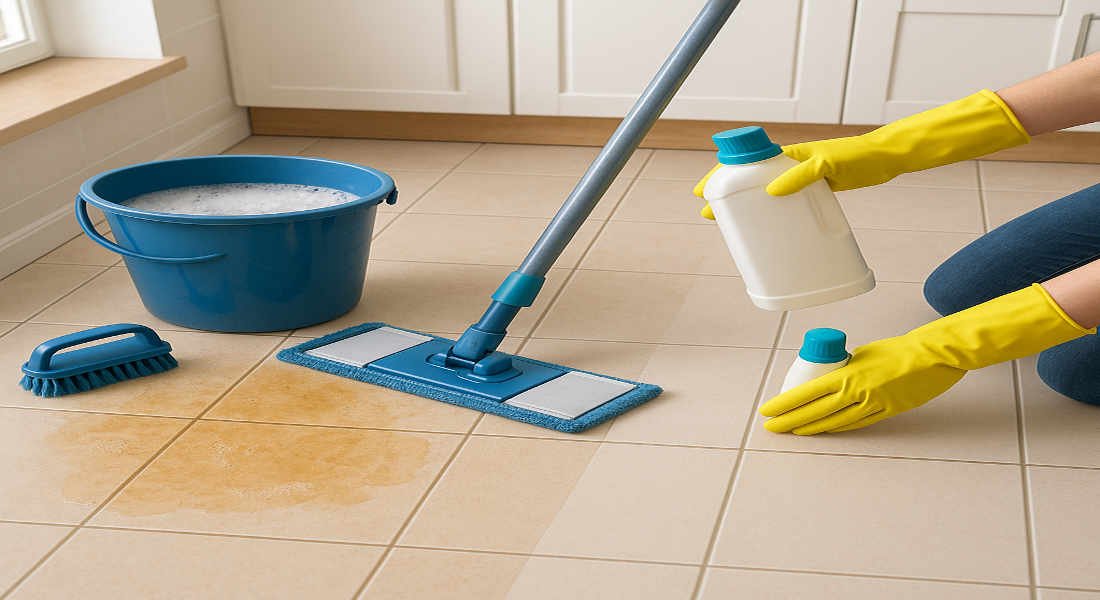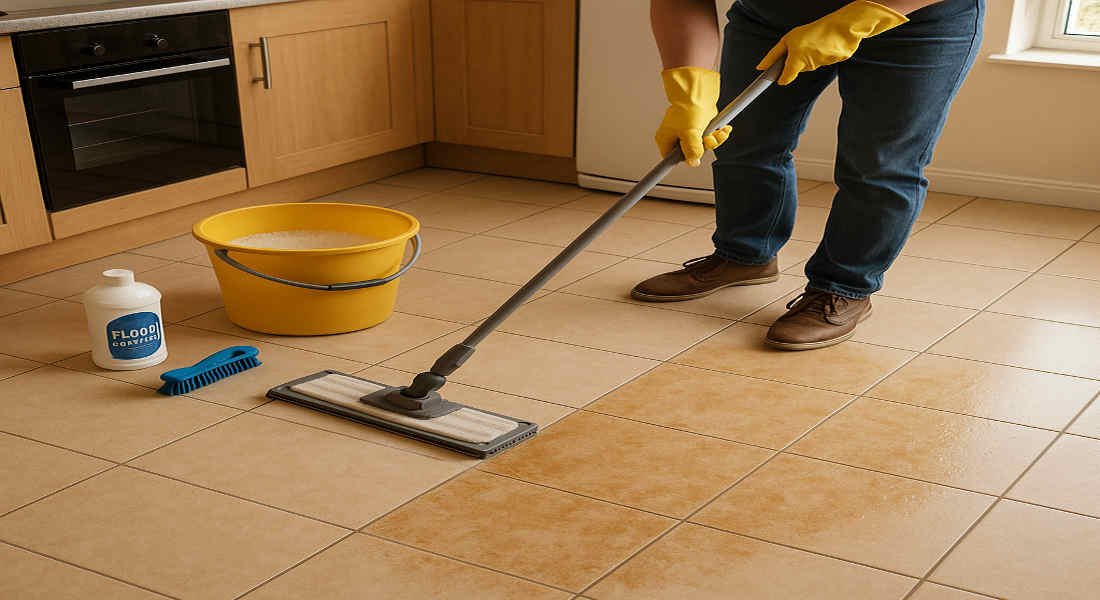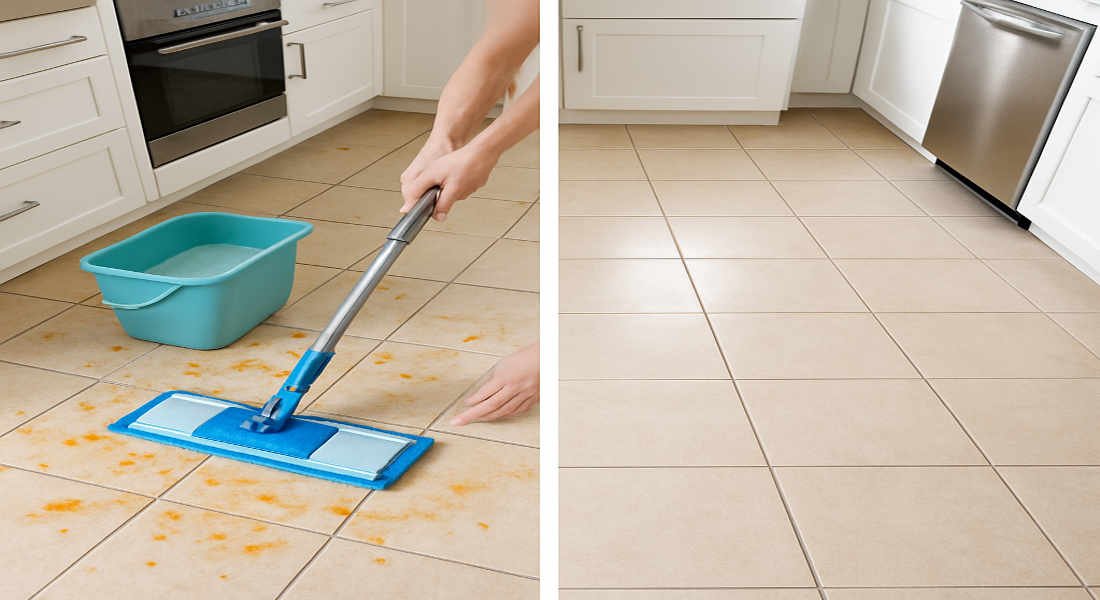Sticky kitchen floors are a common household problem, but they can be frustrating to deal with. Imagine walking barefoot across your kitchen only to feel an unpleasant, sticky residue clinging to your feet. Not only is this uncomfortable, but it also raises concerns about hygiene and cleanliness.
Why Do Kitchen Floors Become Sticky?
Before jumping into cleaning techniques, it’s important to understand why your kitchen floor might be sticky in the first place. Sticky floors don’t just happen—they’re usually the result of specific causes, many of which can be avoided with proper care.
Common Causes of Sticky Floors
- Spills and Food Residues
- Food spills, sugary drinks, and sauces are common culprits. When these aren’t cleaned immediately, they dry and leave behind a sticky film that becomes harder to remove over time.
- Improper Use of Floor Cleaners
- Using the wrong type or an excessive amount of floor cleaner can leave a residue that feels sticky underfoot. Some cleaners aren’t designed for certain floor types, which can worsen the problem.
- Dirty Mop Water
- Reusing the same dirty water while mopping can spread grime instead of removing it. This leads to a sticky buildup on the surface.
- Built-Up Dirt and Grease
- Over time, layers of grease, dirt, and dust can accumulate, especially in high-traffic areas like kitchens. These layers create a sticky coating that regular mopping may not be able to remove.
- Poor Cleaning Tools or Techniques
- Using an old, ineffective mop or skipping essential cleaning steps often results in floors that feel less than clean.
The Impact of Sticky Floors
Sticky kitchen floors aren’t just unpleasant—they can also pose hygiene risks. Left unaddressed, they become a breeding ground for bacteria, mold, and other harmful microorganisms. Additionally, sticky floors can lead to slips and falls, making them a safety concern for both children and adults.
By identifying the root cause of the stickiness, you’ll be better equipped to tackle the problem effectively.
Essential Supplies and Preparation Before Cleaning
Before you start cleaning, it’s important to have the right tools and supplies. Preparation is key to ensuring the cleaning process is both efficient and safe for your home.
You may also read (top flooring materials).
What You’ll Need
Here’s a list of supplies you’ll need to clean your sticky kitchen floor:
- Vacuum or broom – To remove loose dirt and debris.
- Mop and bucket – Any type of mop will work, but microfiber ones are highly effective.
- Soft cleaning cloth or rag – For scrubbing small, sticky spots.
- Mild dish soap – A gentle soap that won’t leave a residue.
- White vinegar – A natural, eco-friendly cleaner.
- Baking soda – For stubborn, sticky stains.
- Ammonia (optional) – Use with caution for tough grime.
- Warm water – Essential for dissolving dirt and grime.
- Magic eraser (optional) – Great for spot cleaning.
Preparing the Kitchen Floor
- Clear the Area
- Remove any items, such as chairs, rugs, or trash bins, from the kitchen floor to make cleaning easier.
- Sweep or Vacuum
- Use a broom or vacuum to remove loose dirt, dust, and crumbs. This step ensures you’re not spreading debris around during mopping.
- Test Cleaning Solutions
- Before applying any cleaning solution to the entire floor, test it on a small, inconspicuous area to ensure it won’t damage the surface.
Safety Tips
- Wear gloves to protect your hands from harsh chemicals.
- Ensure proper ventilation by opening windows or turning on a fan.
- Handle ammonia and other strong cleaners with care, and never mix them with other cleaning agents.
Step-by-Step Methods to Clean Sticky Kitchen Floors
Now that you’re prepared let’s dive into the actual cleaning methods. Whether you prefer basic cleaning routines, homemade solutions, or commercial products, there’s a method here for every need.
Basic Cleaning Routine
- Sweep or Vacuum
- Start by removing loose dirt and debris from the floor.
- Mop with Warm Water
- Dip your mop in warm water, wring it out, and mop the entire floor. Warm water helps dissolve surface stickiness.
- Rinse the Mop Frequently
- To avoid spreading dirt, rinse the mop often and change the water when it becomes cloudy.
Homemade Cleaning Solutions
If you prefer natural and budget-friendly options, homemade cleaning solutions are a great choice.
You may also read (how do i remove the flow restrictor from my home delta faucet).
Vinegar Solution
- How to Use:
- Mix 1 cup of white vinegar with 1 gallon of warm water. Mop the floor with this solution, then rinse with clean water to remove any lingering vinegar smell.
- Why It Works:
- Vinegar is acidic and effectively breaks down grease and sticky residues. It’s also safe for most floor types.
Baking Soda Paste
- How to Use:
- Combine baking soda with water to create a paste. Apply it to stubborn sticky spots, scrub gently with a cloth or sponge, and rinse thoroughly.
- Why It Works:
- Baking soda is mildly abrasive, making it an effective choice for removing tough grime without damaging the floor.
Mild Dish Soap
- How to Use:
- Add a few drops of dish soap to warm water, mop the floor, and rinse with clean water.
- Why It Works:
- Dish soap effectively cuts through grease and removes dirt. Just don’t use too much, as it can leave a soapy residue.
Using Commercial Floor Cleaners
If you prefer store-bought solutions, commercial floor cleaners can be highly effective. Be sure to:
- Choose a cleaner that’s compatible with your floor type (e.g., tile, vinyl, wood).
- Follow the manufacturer’s instructions carefully.
- Avoid using too much product, as this can lead to sticky residue.
Advanced Cleaning Techniques
Ammonia Solution (Use with Caution)
- Mix ½ cup of ammonia with 1 gallon of water.
- Apply the solution carefully, scrub the floor thoroughly, and rinse it well.
- Warning: Ammonia is powerful but can damage certain floor types. Use only as a last resort.
Magic Eraser for Spot Cleaning
- Wet the magic eraser, gently scrub sticky spots, and rinse with clean water.
- Check compatibility with your flooring before using.
Steam Mop
- Steam mops offer a deep clean by using heat to break down grime.
- Avoid using steam mops on heat-sensitive floors, such as wood or laminate.
How to Avoid Sticky Floors in the Future
Prevention is always better than cure. Here are some tips to keep your kitchen floor clean and sticky-free:
- Use the Right Amount of Cleaner: Avoid overusing cleaning products.
- Clean Spills Immediately: Wipe up food and drink spills as soon as they happen.
- Rinse Floors After Mopping: Always rinse with clean water to remove soap residue.
- Change Mop Water Regularly: Dirty water spreads grime rather than cleaning it.
- Maintain Cleaning Tools: Wash and replace mops, clothes, and brushes regularly.
- Deep Clean Periodically: Schedule deep cleaning sessions to prevent buildup.
- Consider Robot Mops: These devices can help maintain cleanliness on a daily basis.
Troubleshooting Sticky Floors
Sometimes, even after cleaning, floors may remain sticky. Here’s what to do:
- If Floors Remain Sticky, Mop again with warm water and vinegar to remove leftover residue.
- For Stubborn Spots: Use baking soda paste or a magic eraser for targeted cleaning.
- When to Call Professionals: If nothing works, professional cleaners have the tools and expertise to handle tough grime.
You may also read (a guide to selecting snake sizes for home drain).
